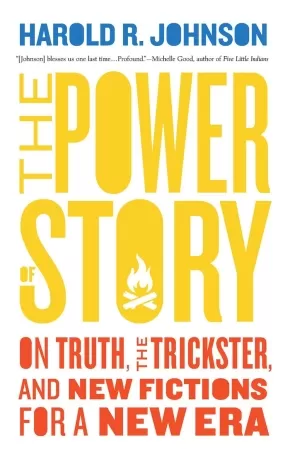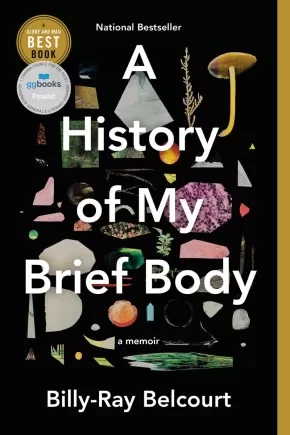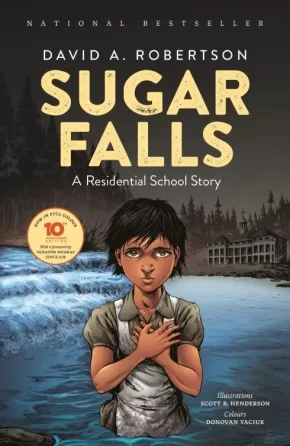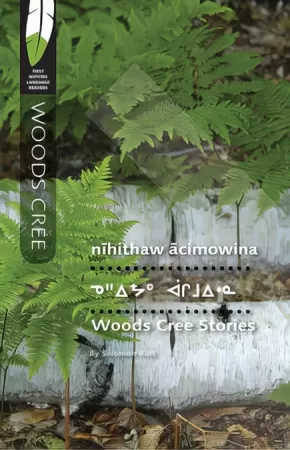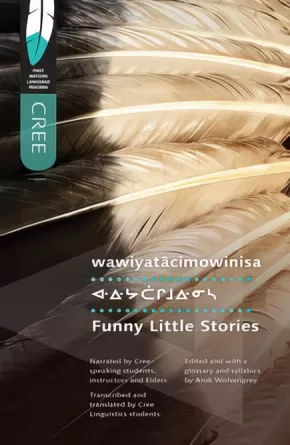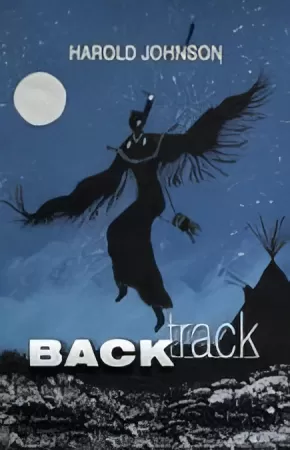
Woodland Cree
16
-
22
of
22 Results;
Sort By
Go To
of 2
The Power of Story: On Truth, the Trickster, and New Fictions for a New Era
$22.95
Format:
Paperback
Text Content Territories:
Indigenous Canadian; First Nations; Cree (Nehiyawak); Woodland Cree; Rocky Cree; Montreal Lake Cree;
Grade Levels: 12; University/College;
ISBN / Barcode: 9781771964876
Synopsis:
Synopsis:
Award-winning Indigenous author Harold R. Johnson discusses the promise and potential of storytelling.
Approached by an ecumenical society representing many faiths, from Judeo-Christians to fellow members of First Nations, Harold R. Johnson agreed to host a group who wanted to hear him speak about the power of storytelling. This book is the outcome of that gathering. In The Power of Story, Johnson explains the role of storytelling in every aspect of human life, from personal identity to history and the social contracts that structure our societies, and illustrates how we can direct its potential to re-create and reform not only our own lives, but the life we share. Companionable, clear-eyed, and, above all, optimistic, Johnson’s message is both a dire warning and a direct invitation to each of us to imagine and create, together, the world we want to live in.
Reviews
"Recently in conversation with a friend I remarked that the whole world is a story. Harold Johnson fills that phrase with profound meaning in The Power of Story as he takes ancient figures and modernizes their storied wit and role in creating the worlds we perceive and the boundaries we need. Harold blessed us one last time with a profound conversation on the role of story in every aspect of our lives."—Michelle Good, author of Five Little Indians
“The Power of Story begins where all great stories begin: around a fire. Harold Johnson gives us a seat at the fire to listen and take into ourselves some spellbinding, bracing, and provocative stories told with a view to healing and transforming. As Harold writes ‘It’s starting to get darker now, and a bright fire will help.’ The Power of Story is that bright fire. And it will help. His final book is a balm for our times.”—Shelagh Rogers
Additional Information
192 pages | 5.00" x 8.00" | Paperback
A History of My Brief Body (PB)
$19.95
Format:
Paperback
Text Content Territories:
Indigenous Canadian; First Nations; Cree (Nehiyawak); Woodland Cree; Woods Cree; Driftpile First Nation;
Grade Levels: University/College;
ISBN / Barcode: 9780735237803
Synopsis:
Synopsis:
A slim but electrifying debut memoir about the preciousness and precariousness of queer Indigenous life.
Opening with a tender letter to his kokum and memories of his early life on the Driftpile First Nation, Billy-Ray Belcourt delivers a searing account of Indigenous life that’s part love letter, part rallying cry.
With the lyricism and emotional power of his award-winning poetry, Belcourt cracks apart his history and shares it with us one fragment at a time. He shines a light on Canada’s legacy of colonial violence and the joy that flourishes in spite of it. He revisits sexual encounters, ruminates on first loves and first loves lost, and navigates the racial politics of gay hookup apps. Among the hard truths he distills, the outline of a brighter future takes shape.
Bringing in influences from James Baldwin to Ocean Vuong, this book is a testament to the power of language—to devastate us, to console us, to help us grieve, to help us survive. Destined to be dog-eared, underlined, treasured, and studied for years to come, A History of My Brief Body is a stunning achievement from one of this generation’s finest young minds.
Awards
- Winner of the Hubert Evans Non-Fiction Prize
Reviews
“Bursting with all the movements of sex, riot, and repose, this book presents us with a shock of recognition and reclamation, and we are better for it―punch drunk and aching but, oh, so much better. I’m gutted by his brilliant mind.” ―Cherie Dimaline
“Displays a pervading lucidity, akin to dreaming while standing wide awake, feet firmly on the soil . . . [A] fascinating exploration of the impact of colonialism in all its ramifications.” —Quill & Quire
Additional Information
192 pages | 5.01" x 7.50" | Paperback
Creeland
$18.95
Format:
Paperback
Text Content Territories:
Indigenous Canadian; First Nations; Cree (Nehiyawak);
ISBN / Barcode: 9780889713925
Synopsis:
Synopsis:
Creeland is a poetry collection concerned with notions of home and the quotidian attachments we feel to those notions, even across great distances. Even in an area such as Treaty Eight (northern Alberta), a geography decimated by resource extraction and development, people are creating, living, laughing, surviving and flourishing—or at least attempting to.
The poems in this collection are preoccupied with the role of Indigenous aesthetics in the creation and nurturing of complex Indigenous lifeworlds. They aim to honour the encounters that everyday Cree economies enable, and the words that try—and ultimately fail—to articulate them. Hunt gestures to the movements, speech acts and relations that exceed available vocabularies, that may be housed within words like joy, but which the words themselves cannot fully convey. This debut collection is vital in the context of a colonial aesthetic designed to perpetually foreclose on Indigenous futures and erase Indigenous existence.
the Cree word for constellation
is a saskatoon berry bush in summertime
the translation for policeman
in Cree is mîci nisôkan, kohkôs
the translation for genius
in Cree is my kôhkom muttering in her sleep
the Cree word for poetry is your four-year-old
niece’s cracked lips spilling out
broken syllables of nêhiyawêwin in between
the gaps in her teeth
Reviews
"Here is an ode to northern Alberta, to the kokums and aunties who are worlds unto themselves, to the vastness and profundity of the Cree language. Dallas Hunt’s Creeland is tender and aching and intellectually exciting. Hunt uses the lyric mode to write another kind of public history about the prairies, one in which we Cree are always beautiful and indomitable. I can’t thank him enough for this." — Billy-Ray Belcourt, February 2021
"Dallas Hunt’s debut collection of poetry is work built from the ground up, meaning he has read, loved, studied poetry. He uses language “lived” in his relationships with family, home, community. Creeland feels like home to me. It “[crackles] with love and life.”" — Marilyn Dumont, February 2021
"From index to glossary, this stunning work bends with the possibilities of saplings. Mortally aware, a mind that can be everywhere “wolf willows and pin / cherries,” here is a poet halting the mallets of supremacy. Dallas Hunt aligns “petals of / larkspur” against the “maw of the inferno” to speak of Creeland. Entwined in “pîsim’s luminous / touch,” the poet’s smile returns home. Bringing forth fine, wry and tenderizing poetry, rickety love begets gale winds, and everyday, constellatory magnitudes. A quieting read with dimensional perspective, this book will transport you." — Cecily Nicholson, February 2021
Additional Information
128 pages | 5.50" x 8.00"
Sugar Falls: A Residential School Story - 10th Anniversary Edition
$21.95
Artists:
Format:
Paperback
Text Content Territories:
Indigenous Canadian; First Nations; Cree (Nehiyawak); Woodland Cree; Rocky Cree; Cross Lake First Nation;
ISBN / Barcode: 9781553799757
Synopsis:
Synopsis:
A young girl struggles to survive residential school in this timeless graphic novel from the bestselling author of The Barren Grounds—a story of strength, family, and culture, inspired by true events, that shares the awe-inspiring resilience of Betty Ross.
Abandoned as a young child, Betsy was soon adopted into a loving family. A few short years later, at the age of 8, everything changed. Betsy was taken away to a residential school. There she was forced to endure abuse and indignity, but Betsy recalled the words her father spoke to her at Sugar Falls—words that gave her the resilience, strength, and determination to survive.
Sugar Falls is based on the true story of Betty Ross, Elder from Cross Lake First Nation. We wish to acknowledge, with the utmost gratitude, Betty’s generosity in sharing her story. A portion of the proceeds from the sale of Sugar Falls goes to support the bursary program for The Helen Betty Osborne Memorial Foundation.
Educator Information
Recommended for grades 9 to 12.
This 10th-anniversary edition brings David A. Robertson’s national bestseller to life in full colour, with a foreword by Senator Murray Sinclair, Chairman of the Truth and Reconciliation Commission of Canada, and a touching afterword from Elder Betty Ross herself.
A Teacher Guide is available for this work: Teacher Guide for Sugar Falls: Learning About the History and Legacy of Residential Schools in Grades 9-12
Additional Information
48 pages | 6.50" x 10.00" | full colour throughout
Woods Cree Stories
$24.95
Format:
Paperback
Text Content Territories:
Indigenous Canadian; First Nations; Cree (Nehiyawak);
Grade Levels: University/College;
ISBN / Barcode: 9780889773455
Synopsis:
Synopsis:
Humour is not only the best medicine; it is also an exceptionally useful teaching tool.
So often, it is through humour that the big lessons in life are learned--about responsibility, honour, hard work, and respect. Cree people are known for their wit, so the tales in Woods Cree Stories are filled with humour. The book includes nine stories--including Boys Get Lost, Foolishness, and Animals Become Friends--and a Woods Cree-to-English glossary.
All the stories are presented in Cree syllabics, Standard Roman Orthography, and English translation and can be enjoyed by those new to the language and more advanced learners.
Educator & Series Information
Woods Cree Stories is part of the First Nations Language Readers series. With a mix of traditional and new stories, each First Nations Language Reader introduces an Indigenous language and demonstrates how each language is used today. The University of Regina Press’s long-term goal is to publish all 60+ Indigenous languages of Canada.
Additional Information
138 pages | 5.50" x 8.50"
Funny Little Stories / wawiyatacimowinisa (1 in stock, in reprint)
$12.95
Editors:
Format:
Paperback
Text Content Territories:
Indigenous Canadian; First Nations; Cree (Nehiyawak); Plains Cree; Swampy Cree ; Woodland Cree;
ISBN / Barcode: 9780889771857
Synopsis:
Synopsis:
This is the first in a series of readers in the First Nations languages of the prairie provinces meant for language learners and language users. The stories in this volume come from a variety of sources, all being narrated or written by fluent speakers of Cree, whether students or instructors of the Cree language or Elders. Funny Little Stories is a collection of nine stories representing the Plains Cree, Woods Cree, and Swampy Cree dialects, with a pronunciation guide and a Cree-to-English glossary.
Students and Elders come together in this volume to offer samples of three distinct genres of Cree storytelling: word play, humorous accounts of life experiences, and traditional stories about Wisahkecahk, the trickster-hero.
Each story is illustrated and is presented in both Standard Roman Orthography and syllabics, with English translation.
Educator & Series Information
Funny Little Stories is part of the First Nations Language Readers series. With a mix of traditional and new stories, each First Nations Language Reader introduces an Indigenous language and demonstrates how each language is used today. The University of Regina Press’s long-term goal is to publish all 60+ Indigenous languages of Canada.
Additional Information
110 pages | 5.50" x 8.50" | Narrated by Cree-speaking students, instructors, and Elders | Transcribed and Translated by Cree Linguistics Students | Edited and with a glossary and syllabics by Arok Wolvengrey
Authenticity Note: Because of the contribution of Indigenous Peoples, such as Cree-speaking Elders, to this work on Cree storytelling, it has received the Authentic Indigenous Text label.
Back Track
$16.95
Format:
Paperback
Text Content Territories:
Indigenous Canadian; First Nations; Cree (Nehiyawak);
ISBN / Barcode: 9781894345859
Synopsis:
Synopsis:
Against a backdrop of traditional Cree mythology, Johnson's novel creates a tangled murder chronicle and harrowing tale of four Cree brothers, bound to each other through family and tradition, separated from each other by their chosen life paths. As one brother kills, another reinforces the principle of a circle of life, as one capitulates to weakness, another conquers his demons. Driving the action is a manhunt for the killer of conservation officers; but at the heart of the story there is reparation through cultural wisdom and the restoration of traditional beliefs.
Authentic and well-paced, Back Track crosscuts through the cultural ruts, economic conventions, and stereotypes of Cree families living in northern Saskatchewan.
Additional Information
|
Sort By
Go To
of 2

